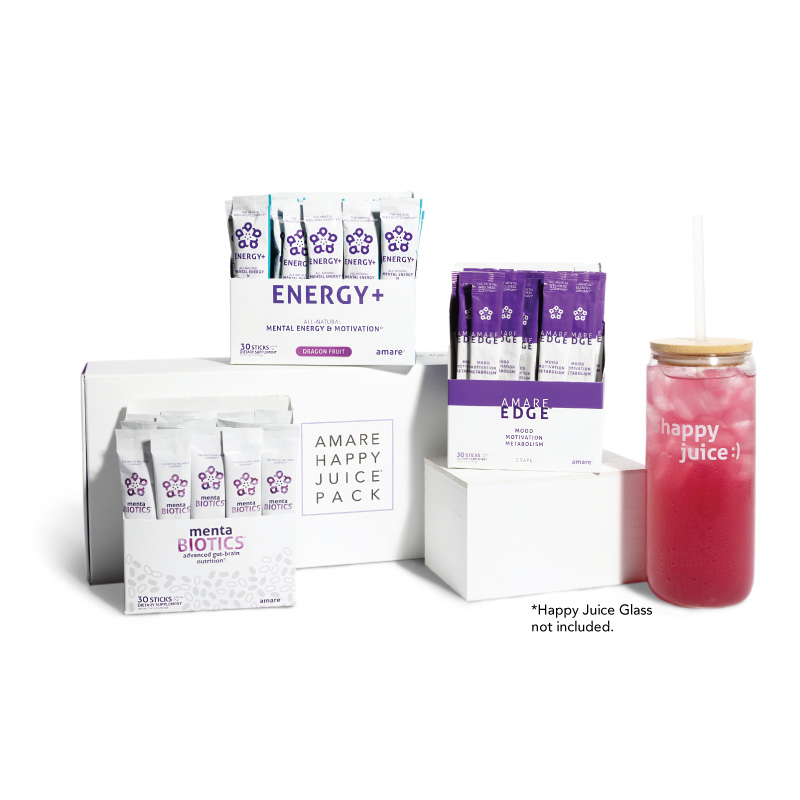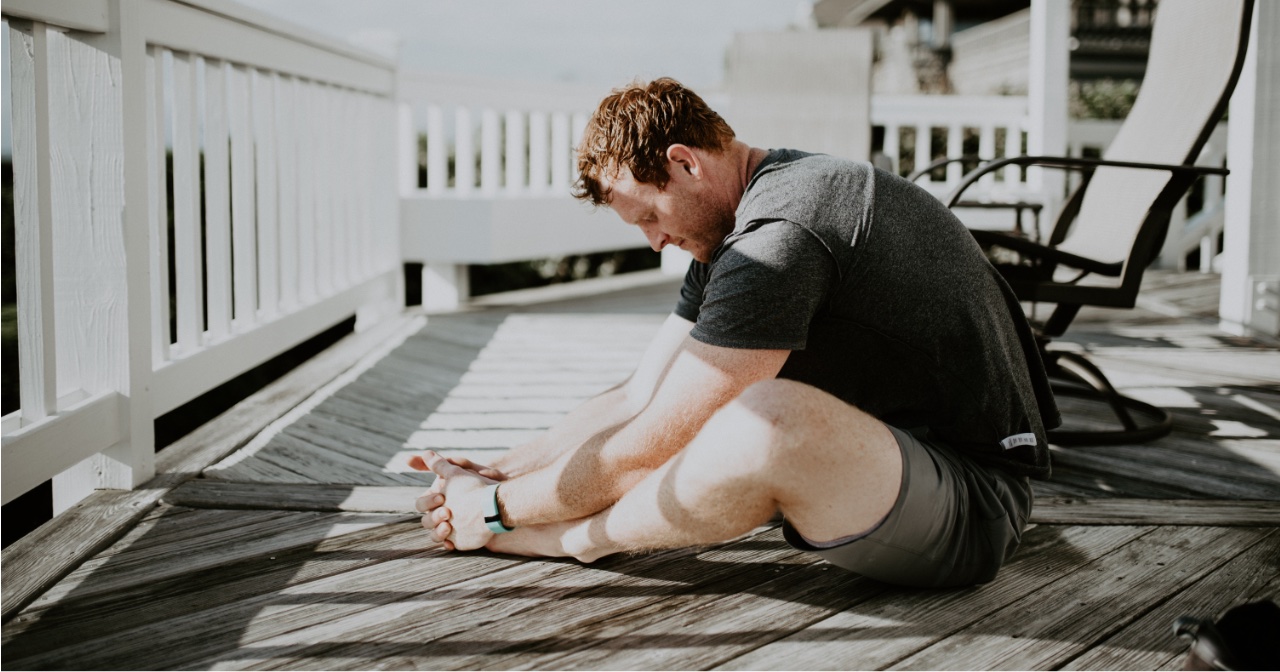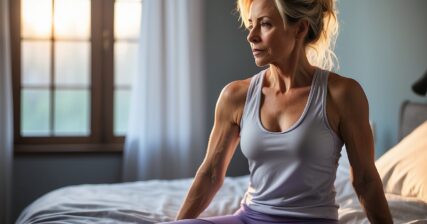Listen on: Apple Podcasts | Spotify
Whether you’re a couch potato or a fitness fanatic, all of us deal with tight, stiff muscles from time to time.
But what causes muscle tightness? Is it good or bad? What exercises, therapies, or muscle rubs reduce muscle tightness?
What is muscle tightness?
When most people describe “tight muscles,” they mean they have restricted movement. They have reduced flexibility, mobility, or both.
Flexibility is a passive range of motion around a joint. For example, you could assess your hamstrings’ flexibility by standing up, locking your knees, bending at the hips, and allowing gravity to draw your upper body toward your toes. Or, a massage therapist could move your leg around your hip joint while you remain relaxed on the table.
Mobility is an active range of motion around a joint. Using your hamstrings as an example again, you could test your hamstrings’ mobility at your hip joint by doing Romanian Deadlifts. You actively lower your upper body toward the floor while holding onto a barbell, and then actively contract your hamstrings to stand back up again.
Mobility has a more “real world” application, as it determines how well you move while your muscles are under tension. If you can move through a full range of motion while your muscles remain under stress, you’ll reduce your risk of an injury.
Women usually have a better range of motion compared to men, but they have a lower pain threshold. They likely have less muscle stiffness but could experience similar pain as men who have stiffer muscles.
Why is this important? Because something like the pain of delayed onset muscle soreness could be more significant in women even if their training program isn’t as intense.
Causes of Tight Muscles
A variety of factors contribute to tight muscles, including a lack of use, misuse, and overuse.
In some cases, the tightness is short-lived. In others, it can be long-term unless you deal with it. Though you could feel stiff in almost any area of the body, you’re most likely to feel tight in your back, hips, and neck.
Poor posture
Your body adapts to your environment. If you sit at a desk with your shoulders hiked up, shoulders and head pulled forward, your back rounded, and legs at a 90° angle at your hips and knees all day, you’ll develop tightness in your:
- upper back and neck (traps)
- chest (pecs)
- front of your hips (hip flexors)
- backs of your legs (hamstrings)
- calves (gastrocnemius and soleus)
This posture contributes to aches and pains in your head, neck, shoulders, low back, and knees. It’s as if all of the muscle groups in your body cause you to slouch forward like an old man or woman.
When I design the workouts for VIGOR Training, I emphasize pulling movements and glute work to correct some of the postural imbalances created from so much sitting.
Sadly, I suspect many children learning in front of a computer during this COVID Circus will develop horrendous posture that could follow them throughout their lives.
Injuries
I ruptured my bicep tendon in 2014. I did everything I could to enhance my recovery after surgery and got back to regular lifting in half the time the surgeon said it would take.
Still, I experience occasional tightness in my bicep and surrounding muscles occasionally.
When you get injured, the injury changes the way your muscles function. Surrounding muscles compensate for the injured ones. Your movement patterns change to work around the injury.
All of these factors can cause tightness in non-injured muscles.
Poor sleep positions
I sleep on my stomach. I realize that’ll make some chiropractors and physical therapists cringe, but it’s how I sleep the best.
Though stomach-sleeping isn’t good for your neck, it’s more problematic when you have a limited range of motion in your cervical spine.
Your pillow and mattress also affect whether you wake up refreshed and mobile, or stiff and in pain.
Vanessa likes a soft mattress. I like it firm. We own a Sleep Number bed, and her Sleep Number is 40. Mine is 100. If I sleep on a softer setting, my hips stiffen up and start to hurt within a few hours.
If you wake up feeling stiff, consider a new pillow, mattress, or even a mattress topper.
Strength training
If you don’t strength train, you’ll very likely develop chronic muscle tightness from poor posture. If you do strength train, you’ll occasionally develop short-term muscle tightness from your training sessions.
Tight muscles and delayed onset muscle soreness (DOMS) often go hand-in-hand. Post-workout muscle damage and swelling cause tenderness and limit range of motion.
Yet, the muscle damage and swelling (along with a high-protein diet and sufficient sleep) make your muscles stronger as they recover.
Also, training with proper form and a full range of motion increase mobility over time.
Overuse injuries
When muscles are chronically overused for a long time, they get tighter.
One example is Temporomandibular disorders (TMD), which can be caused by chewing gum or grinding your teeth. The muscles in your jaw get tense, which triggers tension headaches.
In a study of more than 700 college-aged students, more than one in four had typical signs of TMD.
Stress and anxiety often cause people to grind their teeth at night, so treatments include stress management strategies and medication, along with physical therapy, the use of mouth guards, and occlusal splints.
Overuse injuries can occur throughout the body. You can develop back pain from playing golf, wrist pain from spending much of your day working a keyboard, or shoulder pain from hanging drywall.
How to Reduce Muscle Tightness
The following are some of the easiest ways to improve flexibility or mobility or reduce stiffness and pain. Improving range of motion does not increase muscle length, it simply allows the muscle to move through a longer range of motion.
Rest
Take a break from whatever contributes to the muscle tightness. If you sit too much, take a break from sitting. Go for a walk or go to the gym and get in a good workout.
On the other hand, if an activity or exercise causes stiffness, choose an alternative exercise or workout.
For example, runners and cyclists often develop a forward head tilt and rounded shoulders, just like a desk jockey. The forward head tilt leads to headaches and neck pain. Reducing endurance days and increasing strength training days could eliminate the pain and postural issues while maintaining, or even improving their fitness levels.
Strength train
Resistance training retrains your nervous system and muscular system to sit, stand, and move most effectively and safely.
While building muscle is a significant strength training benefit, training with proper form and a full range of motion increase mobility.
Get a massage
Experienced massage or physical therapists manipulate trigger points in tight muscles with their hands or dry needling. Manipulating the trigger points release tension and relax the muscles.
It’s painful at the moment, but can significantly reduce stiffness in the hours and days following the massage session.
Take a yoga class
Yoga improves mobility, along with reducing stress and anxiety. Because you use only your body weight as resistance, it’s also safe for almost everyone.
We’re talking about improving your range of motion, and not becoming a hardcore yogi, so most yoga classes will work. I appreciate the benefits of yoga practice and ignore the spiritual aspect of it.
Apply topical menthol
Not only does menthol reduce delayed onset muscle soreness, but it also improves the range of motion in stiff muscles. Menthol comes from the essential oils of peppermint and wintergreen.
My favorite menthol-related topical cream is Young Living Cool Azul Pain Relief Cream.
I often use it when I’m sore from my VIGOR Training workouts.
Prep before you workout
Each VIGOR Training workout includes prep work before the actual training session.
While it’s also a “warm-up,” the prep work increases muscle activation and improves mobility before putting significant physical stress on your joints.
Though you can get by with jumping right into a training session when you’re young, the older you get, the more important it become to properly “prep” your body before you workout.
Summary
Mobility becomes more vital as we age. Not only will it allow you to play with your kids and grandkids longer, but it’ll also keep you from getting hurt and can enhance your physical performance.
When you’re ready to take charge of your fitness, improve your mobility, and build a stronger, healthier body, try VIGOR Training. With a money-back guarantee, there’s no risk, and you could gain much reward.

Feel Better Fast. Guaranteed.
Energy+, EDGE, and MentaBiotics make up the Happy Juice supplement stack, with ingredients clinically proven to:
- decrease anxiousness scores by 55%
- decrease irritability scores by 60%
- decrease fatigue by 64%
- decrease anger 54%
- decrease tension by 45%
- decrease confusion by 43%
- decrease overall distress by 49%
- increase good bacteria by 70%
- decrease negative mood by 105%
- increase positive mood by 211%



